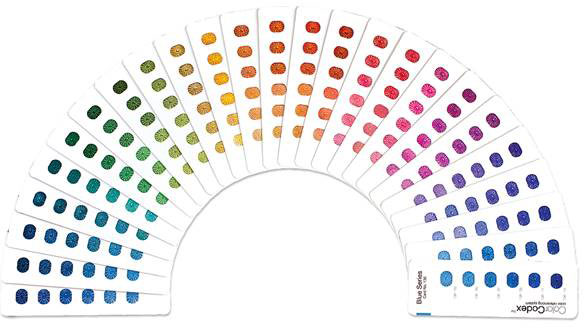Describing a gem's color
When it comes to colored gemstones, the most important characteristic is color. Cut, clarity and carat weight also play their parts, but the star of the show is color.
That may seem obvious, but describing color accurately can be a tricky business. A consumer may choose a gem because the color is "beautiful" and "I know what I like." For appraisers, charged with determining valuation, judging a gem's color requires precision. That description has financial consequences.
But how to describe a gem's color?
In earlier times, experience of the natural world sufficed: canary yellow, moss green, sky blue, lime, sea, forest, cardinal, cherry, orchid . . . etc.
   What color is "sky blue"? |
Some sellers, and even some appraisers, still use terms like that. In fact "pigeon's blood" rubies command some of the highest prices. The term has a long history in gem descriptions but today gemologists disagree on exactly what color that is. The dispute prompted one appraiser to suggest how the question could be decided: "First you have to catch a pigeon, then you have to kill it . . ."
Since color is such a crucial determinant of value, it's clear that precise terminology is needed. For example, the price difference between pink corundum (sapphire) and red corundum (ruby) can be enormous, but the color variations can be quite subtle.
 When does "pink" become "red"? |
A number of systems have been created to describe how color appears to the human eye. Chief among these is the Munsell color system, developed early in the 20th century by Albert H. Munsell, an American painter and art instructor.
GIA created a consistent and systematic way to communicate color in faceted transparent gems. Basing its system on Munsell, GIA's system describes color in terms of hue, tone and saturation.
Hue
Hue is what we commonly think of as color. The GIA specifies 31 gemstone hues. They include terms such as blue, slightly greenish blue, very slightly greenish blue, bluish green, and so forth. The GIA has prepared a color chart showing the hues and their designations.
Tone
Tone refers to the lightness or darkness of a color. The GIA has determined 9 levels of tone, ranging from very very light to very very dark.
Saturation
This is the degree to which a color departs from a neutral (gray) sensation. Saturation can be thought of as the relative purity of a hue. The GIA specifies 9 terms, such as brownish, grayish, moderately strong, and vivid.
Thus an emerald's color might be described as having "very slightly bluish Green" hue, "Medium Light" tone, and "Very Slightly Grayish" saturation. Although words like "grayish" and "medium light" may sound like loose descriptions, within the GIA grading system they are very specific gemological color theory terms. See here for a more detailed look at this system.
Other Color Grading systems
There have been other approaches to describing gem color. ColorCodex, one of the most recent, consists of a set of color cards to which the user compares the gem being graded. Each color on the cards has a number, and the closest match to the gem would be the gem's color grade or color description.
Developers of the system say that it is more reliable than GIA's system because it more realistically represents a gem's color, brilliance and intensity. However, the color "description" does not use words; it is a number code, two digits plus two digits, that corresponds to the color pictured on one of the cards. Without a set of these cards the numbers are meaningless.
Another system, the World of Color, relies on a book of colors following the Munsell system. The user places a faceted gem crown over a color swatch to create a three-dimensional presentation of the printed color as a gem, and compares that to the gem being appraised.
GemE Wizard is a computer-based color comparison system. The user picks the hue of the stone and the screen displays variations of the selected hue to choose from. An inherent problem is that screen color displays can vary.
These and other systems aim to make color descriptions more accurate. But if the terms used by these systems appear on an appraisal, anyone reading the appraisal—a replacement appraiser, for example—must have the same equipment and be using the same system as the appraiser. They both must be speaking the same language.
The various systems have their advocates, but none of these systems is widely used. The GIA color grading system has the advantage of being taught by the respected Gemological Institute of America and used by appraisers throughout the world. It's a universally understood gemological language.
Insurers should see the terms tone, saturation and hue (or the comparable terms: value, chroma and hue) on the appraisal's description of color. If not, the description should be rejected.
Colored Gem Certificates???
For white diamonds, a lab report from GIA is considered the highest authority.
Unfortunately, we cannot recommend any lab for producing reports that adequately describe colored gems. Even GIA, which developed the color description system discussed in this article, does not follow its own system on its colored gem reports, but gives only hue. In a future newsletter we'll discuss these lab reports in more detail.
A lab report may have other information useful in determining value, such as the stone's origin, whether it is mined or lab-grown (sometimes called synthetic), and whether it has been treated, but don't count on a cert for color description.
For now, we have this advice: when insuring transparent colored stones of significant value, be sure that the appraisal describes the gem's color in terms of tone, saturation and hue (or the comparable terms: value, chroma and hue).
FOR AGENTS & UNDERWRITERS
Since none of the certificates for colored gemstones carries sufficient color information, it is crucial to have an appraisal that does. Be certain that all color elements (tone, saturation and hue) are stated. The appraisal should also have a color correct photo of the jewelry, should state whether the gem is mined or lab-grown, and list any treatments.
Some jewelers and appraisers may use other grading systems or even a nomenclature of their own. This is unacceptable. Unless the description is based on a system that is widely understood, and one that is standardized to produce repeatable results, the color grade is meaningless.
Most jewelers and appraisers are experienced primarily with diamond jewelry. For colored stones, it is essential that the appraisal be written by a gemologist experienced with colored gemstones and familiar with current pricing, treatments and frauds.
Preferably, the appraisal should be on JISO 78/79 form, written by a trained gemologist (GG, FGA+, or equivalent), with additional insurance appraisal training. One course offering such additional training is the Certified Insurance Appraiser™ (CIA) course of the Jewelry Insurance Appraisal Institute, Oakland, CA.
 The color description discussed here also applies to richly colored diamonds, known as fancies. Such diamonds are extremely rare in nature and very expensive. Stones at more accessible prices include lab-made diamonds in various colors and mined or lab-made diamonds that have been color enhanced. Lab-grown gems should be so identified on the appraisal, and color treatments should be noted.
The color description discussed here also applies to richly colored diamonds, known as fancies. Such diamonds are extremely rare in nature and very expensive. Stones at more accessible prices include lab-made diamonds in various colors and mined or lab-made diamonds that have been color enhanced. Lab-grown gems should be so identified on the appraisal, and color treatments should be noted.
Clarity treatments, such as fracture-filling, can drastically lower the value of a gem. Be especially attentive with emerald, a highly fractured material that is often subjected to this treatment. All clarity treatments, or enhancements, should be listed on the appraisal.
FOR ADJUSTERS
Compare the sales receipt with the appraisal. If there is a great discrepancy between selling price and valuation, the selling price probably reflects value more accurately. If the sale price seems too low for the appraised value, it's possible that the gem was fracture-filled, or was lab-made, or was a lower-value substitute, such as spinel passed off as ruby. A jewelry insurance expert may help in determining this.
If a claim is made for damage, ALWAYS have the damaged jewelry examined in a gem lab by a trained gemologist (GG, FGA+, or equivalent), preferably one who has additional insurance appraisal training, such as a Certified Insurance Appraiser™.
While there are fewer claims on colored stones than on diamonds, colored stones usually have much higher markups and generally have inflated valuations. Most buyers are totally unfamiliar with colored stones, and the pricing abuses are great. Be sure the appraisal comes from an appraiser familiar with the market on colored stones.
Check all documents for mention of color treatments or clarity treatments, such as fracture-filling. Treated (also called "enhanced") gems have a significantly lower value than untreated gems of similar appearance. Appraisals that simply say "enhanced" (without naming the enhancement) should be rejected.
Lab-made gems have a lower value than mined gems of similar quality. Lab-grown gems are often marketed by the manufacturer's name. If there are names or terms on the appraisal or other docs that you don't understand, it may be worthwhile to consult a jewelry insurance expert.
©2000-2025, JCRS Inland Marine Solutions, Inc. All Rights Reserved. www.jcrs.com







